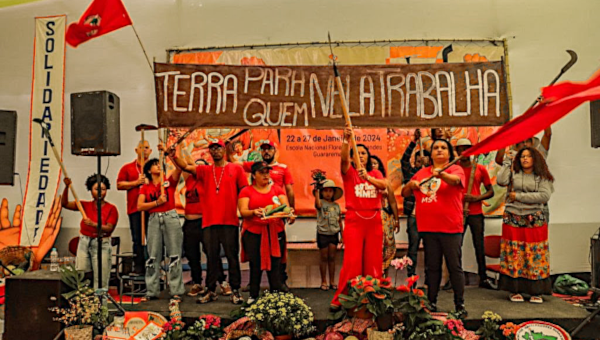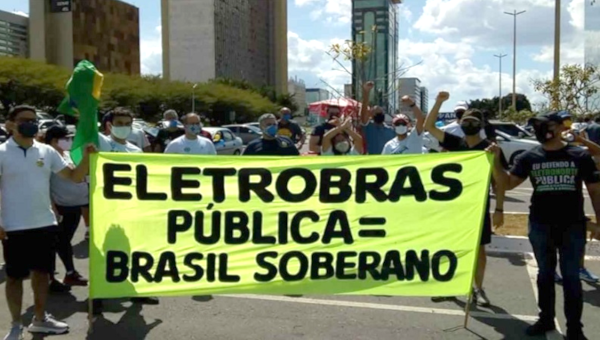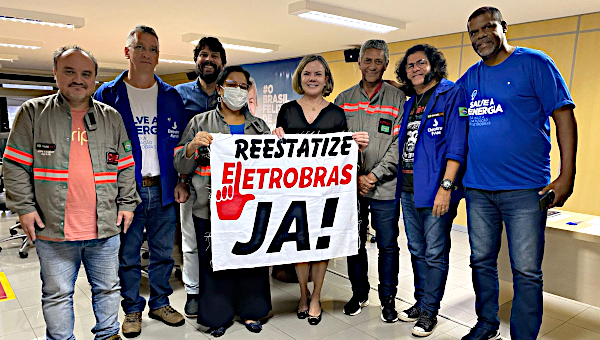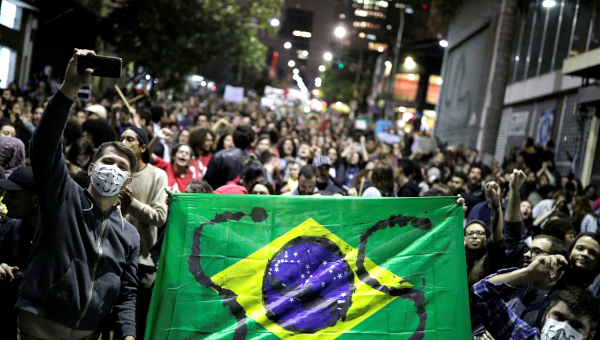Since reaching its zenith in 2010, the Brazilian economy has suffered a remarkable reversal of fortune. Despite official protestations to the contrary, however, Brazil’s afflictions turned out to be of its own making, as it so often proves to be the case.
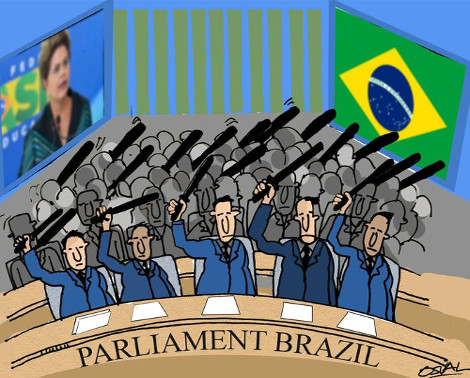
The origins of the contraction of Brazilian GDP in 2015-2016 by nearly 7.5% can be traced back to the economic policies implemented during President Dilma Rousseff‘s first administration.[1] Between 2011 and 2014, Brazilian economic growth was halved, averaging only 2.1% annually, in comparison to 4.4% average in the 2004-2010 period.
But the slowdown of economic activity was only the first consequence of a series of policy changes promoted by the Workers’ Party (Partido dos Trabalhadores, PT)
government under President Rousseff with the deliberate purpose of reducing the direct role of the state in the economy, although important social inclusion policies concerned with decreasing inequality remained in place during that period.
The chief objective of this policy change was to signal that the successful strategy pursued until 2010, in which the state played a central role directly promoting economic growth, would no longer be pursued. This strategy was implemented chiefly via the public sector (including state-owned companies and public banks), by stimulating aggregate demand and generating supply-side structural change through public investment.
Political Resistance from Business
This development policy enabled robust growth to be consistently achieved and allowed significant reductions in inequality to be promoted. However, the resulting changes both in the Brazilian social matrix and in labour-market relations generated growing political resistance from the country’s financial and business communities. Even at the height of prosperity, large private media groups and economists associated with, or sponsored by, large private banks, were particularly vocal in expressing their discontent.
In an attempt to placate this mounting wave of criticism, President Rousseff and her party (with the public acquiescence of former President Lula da Silva) decided by the end of 2010 to endorse the view that the government was intervening “too much” in the economy.
Instead of acting as a primer for aggregate demand expansion, the government’s economic role was shifted to one of slowing down the growth of domestic demand and providing incentives for private investment, in the shape of substantial and unconditional tax cuts to businesses, together with a (quickly reversed) reduction of interest rates, and a large exchange-rate devaluation. Unlike more traditional trickle-down theory, the rationale underlying this policy was that it would stimulate private business to lead economic growth, instead of following in the wake of public investment and social transfers, as had happened in the previous decade.
This policy shift initiated in 2011 proved ineffective and, as public-sector investment fell sharply, no corresponding increase in private investment and net exports materialized. The downward effects were compounded when unusually dry weather and mismanagement of the energy policy guidelines imposed on Eletrobras, the large state-owned electricity company, pushed the country close to a serious power shortage in 2014, despite the fact that demand was weak because domestic economic activity had been decelerating steadily for four years.
Instead of reverting to the successful policy trajectory of 2006-10 and seeking to improve long-term planning through better technological and infrastructure policies, the second Rousseff administration (inaugurated in January 2015) decided to double down on its market-led strategy. From the first day of its new term in office, the government fully committed itself to implementing the policies championed by the defeated conservative opposition during the recent 2014 election campaign.
In fact, President Rousseff’s government went significantly further than that. Working in close concert with Brazil’s redoubtable financial industry (the new Minister of Finance came into office straight from the Executive Board of the country’s largest private bank), the PT-led government had put in place a more radical version of the austerity recipe favoured by many developed countries and multilateral institutions.
This neoliberal U-turn was translated into an unprecedented combination of public spending cuts, consecutive interest-rate hikes, an array of credit-inhibiting measures, and large increases in utility prices. By deploying simultaneously every available policy tool that can decelerate economic activity, while allowing a substantial exchange-rate devaluation to occur, Brazilian authorities created a perfect storm of austerity that plunged the country in what was to become the biggest recession in its history, with a net loss of 1.6 million formal jobs in 2015 alone.
Blaming International Conditions
Given that five years of continually deteriorating, and ultimately collapsing, macroeconomic figures – including eight consecutive quarters of falling investment – cannot easily be swept under the carpet when it comes to an economy the size of Brazil’s, the official line of the PT-led government was one of explaining away the negative results of deliberate economic policy choices by blaming adverse international conditions.
However, changes in external economic conditions, such as trends and composition of the balance of trade, or the availability of external finance have had very little direct impact on the overall performance of the Brazilian economy over the past five years.
Brazil’s exports grew only feebly between 2011 and 2014 (1.6% on average), primarily as a result of much weaker world trade, combined with a sharp fall in commodity prices. However, this underwhelming performance had a virtually negligible direct effect on aggregate demand, once the small relative weight of exports in Brazilian GDP (of around 11%), as well as the very high import coefficient of many key Brazilian exports, are taken in account.
More relevantly, Brazil has not faced even the remote threat of a balance-of-payments crisis at any point of its trajectory from economic deceleration to stagnation to collapse. Foreign debt has remained at historically low levels (under 16% of GDP) from 2010 to 2014, being even lower than that by July 2015, while international reserves stood at historical peak levels throughout the period and, at $370-billion (U.S.), currently amount to nothing less than 20% of GDP.
Despite this solid balance-of-payments position, the threat of Brazil’s sovereign credit rating being downgraded by private international agencies (which finally came to pass on March 2015) was repeatedly invoked as one of the main arguments used by financial market economists and Brazilian government officials alike to justify even deeper spending cuts and ever wider austerity measures being implemented domestically. Thus a contrived conflation between domestic public debt denominated in local currency and the country’s foreign liabilities in hard currency (both private and public) was introduced at the heart of the Brazilian economic debate and presented as a crucial linchpin for preventive, and subsequently, corrective contractionary policies.
This rhetorical artifice was taken even further when Standard & Poor’s textually reaffirmed Brazil’s strong foreign-exchange position in the body of the very same document that announced that the country’s foreign currency ratings were being stripped of investment-grade status, in early September 2015.[2] The rating agency justified placing Brazil below investment grade because of its “fiscal performance” and of the “rise of net general government debt.” The report goes on to mention Brazil’s “low external financing needs” and “its high level of international reserves.”
From a macroeconomic standpoint this raises more questions than it answers since it is by definition impossible for any government to be compelled to default on internal debt denominated in its own currency. In any country where the Central Bank can buy and sell any quantity of short-term government bonds in the secondary market to set the basic interest rate of the economy, any bonds not purchased by the private sector can be (and usually are) bought by the central bank itself at the set interest rate. For some reason, this simple fact of public finance was ignored by both Brazilian advocates of ever-growing austerity and the analysts of U.S. credit-rating agencies.
To be fair, when taken to court in the U.S. (and Europe) over their role in the financial crisis of 1997, credit rating agencies stated through their lawyers that their ratings are merely “expressions of opinion,” protected as free speech, and should not be construed as anything other than that.[3]
President Rousseff, however, took these mere “opinions” very seriously and the downgrading by S&P was ostensibly used to justify yet another round of spending cuts. The result was that even though exports are not a significant direct source of aggregate demand in Brazil, and in spite of the fact that for years the country has had comfortable levels of foreign-exchange reserves and relatively low levels of foreign debt – in other words, that there was no threat of balance-of-payments problems on the horizon – the international crisis was blamed for the economic downward spiral brought about by the government’s increasingly restrictive and orthodox policies.
Justifying Austerity
Until recently, Brazilian authorities made use of orthodox rhetoric to justify the austerity measures that effectively derailed the Brazilian economy. That came either under the guise of the standard ‘the international crisis made me do it’ discourse just described, or by resorting to the notion that fiscal (and, in Brazil’s case, also monetary and credit) pains are the only way to ensure growth gains.
As it turns out, the previously unstated purpose of the set of policies currently being implemented in Brazil is to weaken the bargaining power of workers by reducing real wages and by increasing unemployment. The institutional ensemble that protects the interests of labour in Brazil is comparatively weak and lacking both in organic and in party-political clout. Thus, swelling the ranks of unemployed workers has the added benefit of effectively reducing the political resistance to the introduction of the neoliberal measures necessary to reverse the advantages gained by labour over the past decade, perceived as being excessive.
In June 2015, Finance Minister Joaquim Levy told an audience of business executives, in the presence of both local and international press, that it was time to “rethink the country” and that he intended to “abandon rhetoric and face some realities.” His declared aim was clearly spelled out: “We are going to have to reverse this reduction in the supply of labour.” According to Minister Levy, there were people who previously “did not want to join the labour market, who now will have to look for jobs,” thus causing labour supply to be increased.[4]
Mr. Levy’s political diagnosis was an accurate, if somewhat blunt, one. The bargaining power of the Brazilian workforce was, perhaps inadvertently, much increased by a tight labour market between 2006 and 2014, as well as by successful social policies introduced by the PT-led government over that period. Unemployment had fallen markedly and average real wages in the formal sector increased continuously, at a steady average of 3% annually, beginning in 2006. Even more relevantly, having reached a deep trough in 2004, the wage share of GDP had been recovering since then.
After continued political pressure from private business (despite record-high profit levels reached in the preceding decade) and, even more vocally, from large media groups and opposition parties, in 2015 the PT-led government decided to act in earnest to reverse this state of things by means of increasingly strong measures.
The fast growth of unemployment by means of radical austerity policies, as well as sharp shifts in income distribution away from wages, have created a political climate in which it is possible substantially to decrease the size and importance of the Brazilian state in the overall economy. This, in turn, has paved the way for a roll-back of distributive gains, labour rights and social benefits put in place since 2003, some of which are even now being either dismantled or significantly reduced.
Many PT militants, as well as social movements and trade unions, were clearly taken aback by this open endorsement of a neoliberal agenda they had together long opposed, and one that hurts their own working-class base the hardest. This reaction, if understandable, is somewhat predicated on wishful thinking. Closer empirical analysis of its 30-year history reveals that, once they are in power (whether at local, state or federal level), the PT has an established tradition of avoiding direct confrontation with the country’s conservative property-owning classes. While they sincerely appear to want to promote social change, the Workers’ Party’s top people have long been steered by a consensus-seeking credo, according to which there is no situation where a compromise that avoids upsetting Brazil’s moneyed elite, while simultaneously improving the lot of the country’s huge underclass, cannot be reached.
This unlikely squaring of the political circle had seemed possible prior to 2011, at the federal level, in the wake of a foreign-exchange bonanza, coupled with the extraordinary surge both in domestic consumption and in profit levels that followed the initial opening of the social inclusion floodgates. But as sporadic conflicts in the political arena over income distribution became more widespread, and ideological criticism gave way to undisguised class antagonism, the previous self-congratulatory mood among the then ruling party’s top brass changed into one of diffidence and alarm.
Faced with a hostile new Congress after winning the 2014 presidential elections, and weighed down by its heavy dependence on funding from big private firms and banks, the PT leaders’ pliable ways and placatory beliefs translated into a seldom seen episode of top-down political capitulation.
Fighting Corruption
Throughout those troubles, public debate in Brazil gave virtually no emphasis to any of the key economic and political factors mentioned so far. Since 2014 the country daily devotes its full attention not to policy, but to police matters.
Since at least the days of the late President Vargas, in the early 1950s, public corruption has been the go-to political tactic of the Brazilian conservative establishment whenever a situation seen as unduly imbalanced in favour of labour needed to be tackled in short order.[5] And that is precisely the perception that took shape over the course of President Rousseff’s administration, and was solidified by the defeat of right-wing candidates Aecio Neves and Marina Silva in the 2014 elections.
Even though from her first days in office President Rousseff’s policies of reducing the government’s role in the economy and promoting unconditional tax cuts to business ostensibly aimed to please both the Brazilian private sector and foreign investors, recurring economic and political mismanagement resulted in that, by the end of her government’s first term in 2014, those policies in practice served no one. Business saw growth and profit levels go down and investment fall, while the labour market remained tight. Workers also had little to celebrate as household disposable income stagnated then fell, and jobs became increasingly thinner on the ground.
From the perspective of Brazil’s traditional economic and political elite, it had become plain by then that change would have to be much deeper and to come much faster. For those familiar with Brazilian political mores over the last century it should not come as a surprise, then, that long-prevailing but shady contracting practices involving the country’s state-controlled oil and gas company, Petrobras, became an overnight ‘outrage’ and began to be treated as nothing short of a national emergency.[6]
What is perhaps less widely known outside Brazil is that, this time around, the anti-corruption discourse was not placed at centre-stage by the conservative opposition alone, but was in fact ushered in and given priority status by President Rousseff herself. Since taking office in 2011 she repeatedly stressed her personal commitment to prosecuting “wrongdoers” and fighting corruption “regardless of whom it might hurt,” quickly dubbed by both domestic and international press as a “clean-up” (faxina) operation.
By the end of 2013, however, the anti-corruption broom, as it were, had changed hands. It was no longer merely a case of producing media sound bites, replacing the odd cabinet minister, or conspicuously introducing new (and increasingly cumbersome) regulatory compliance requirements, as the PT-led government had been doing so far. The probes into Petrobras’ dealings that began a few months earlier were being conducted by groups clearly hostile to the ruling party and its leaders, and when the first indications of the involvement of politicians surfaced, President Rousseff’s government and former President Lula da Silva became the obvious political targets, despite the fact that both situation and opposition politicians were equally implicated.
The reverberations of the ensuing media campaign were greatly amplified by the eagerness for the limelight of politically ambitious magistrates and prosecutors, whose every action received instant praise from the country’s media oligopoly, long openly sympathetic to the opposition camp. This represents a new historical development, signalling a departure from an established tradition of Brazilian judicial officials keeping out of politics that, in its own right, could add a different dimension to future political use of the anti-corruption discourse in the country.
The steep fall in popularity resulting from the Petrobras ‘scandals’, together with poor management of party alliances, both in Congress and within the Cabinet, pushed the Rousseff administration into a singularly fragile political position. This, in turn, has made it easier to shift economic policy toward austerity even further, as it built on an already dominant trend among PT party leaders since the October 2014 elections, to do whatever could be done to meet “market” (i.e., big private business groups, large private banks, and the media oligopoly) demands.
The job losses and business slump brought about by these austerity policies then took their own toll in further eroding the government’s popular support, thus closing the cycle.
Poor Political Judgement
Former President Lula and the PT led a partially successful opposition to both macroeconomic austerity and neoliberal reforms during the 1990s, which helped Brazil escape some of the worst impacts of neoliberalism in Latin America. Twenty years later, however, the wheel had come full circle.
The adoption of austerity policies and the ensuing effects of growing unemployment and tumbling real wages were reflected in the reduction of 16.7% in the total wage bill of the Brazilian economy, in real terms, over the last 22 months.[7] These results hit the PT government’s natural working-class constituency very hard, effectively estranging it from its political base.
The adoption of an anti-corruption agenda, and the flurry of inaction that followed its appropriation by right-wing judicial officers, gave their opponents added legitimacy to wield the traditional Brazilian tool used for pruning overgrown political forces from outside the traditional establishment.[8]
Thus, through a remarkable display of poor political judgement (and even poorer political principles), President Rousseff and the PT leadership effectively cut the ground from under their own government’s feet. After seeing their candidates lose four general elections in a row, from 2002 to 2014, the traditional right-wing political establishment, and their sponsors in finance, industry and agribusiness, finally had the means for ridding themselves of a persistent nuisance.
“As a result of being associated with recession, unemployment and corruption by voters, the PT-led government faced the lowest popular approval ratings in Brazilian politics since the early 1990s”
As a result of being associated with recession, unemployment and corruption by voters, the PT-led government faced the lowest popular approval ratings in Brazilian politics since the early 1990s, and saw its congressional support melt away very swiftly. The political opportunity was immediately seized upon. Impeachment proceedings were instituted against President Rousseff, and after a few months of hearings the Senate voted on 12 May 2016 to remove her definitively from office. According to many experts, the criminal charges brought against the President failed to meet the minimal legal and evidentiary burden of proof under Brazilian law. Outside observers often consider these to be moot points, however, in view of other conditions laid down by the Brazilian Constitution.
The impeachment process was presided over by the Chief Justice of Brazil’s Supreme Court, and, crucially, the President could not have been removed had she secured the support of at least one-third of the members of either of the houses of Congress, which, it is argued, constitutes an absolute minimum requirement for democratic governability. However egregious the legal technicalities may have been, the political verdict of this quintessentially political process, once set in motion, was never in any doubt.
Post Impeachment
Since taking office, the new administration, headed by former Vice-President Michel Temer, quickly proceeded to set up a parliamentary alliance with the main right-wing opposition parties to the outgoing PT-led government. A thorough ministerial cabinet reshuffle was carried out, and not a single name from the previous administration was kept in office, down to the Governor of the Central Bank and the heads of public banks and state enterprises.
By then, in addition to the sharp contraction of 2015, Brazilian GDP had fallen by 5.4% in the first quarter of 2016, compared with Q1 2015, with 400,000 more formal jobs being lost, bringing the grand total to 2 million since January 2015. To make matters worse, prospects for recovery seemed farther than ever as recession reached every economic sector and region in the country.
In spite of the deep recession, the new government fully reaffirmed their commitment to the neoliberal economic agenda set by the outgoing PT administration, to the point of explicitly adopting austerity measures their predecessors left in draft form. The implementation of a long-term “fiscal reform” to replace the continuous sequence of ad-hoc spending cuts was the most notorious case in point. This now includes the imposition of a 20-year public expenditure ceiling that will sharply reduce funds allocated to health, education and social transfers. The proposal for a comprehensive “pensions and benefits reform,” currently being submitted to Congress was another legacy from the previous government. Also in line with the Workers’ Party policy agenda is the current proposal to rewrite Brazil’s Labour Code (the CLT), altering the ceiling for weekly working hours, and allowing privately contracted working conditions to supersede requirements established by law.[9]
The Right: Divided and Jockeying for Position
Once the PT-led government was gone, the single thread binding together the wide array of conservative forces that collaborated to oust it was cut. After the initial scramble to fill the most strategic offices, it became apparent that the main parties comprising the new government’s parliamentary base have keenly divergent interests on at least two different, if related, fronts.
First, a large and mounting number of influential politicians within those parties have been directly linked to accusations of corruption in one or other of the scores (literally) of investigations instigated to topple Dilma Rousseff’s government and to put the main leaders of PT – specially former President Lula da Silva – out of politics, or in jail. Which of the political bosses will face prosecution and which will remain in play is a key element for the second major issue driving apart the conservative forces that back Mr. Temer’s administration, namely, the jockeying for position ahead of the 2018 general elections for president, state governors, Congress etc.
Thus, three conclusions can be drawn from the present state of political affairs in Brazil. First, infighting among right-wing forces in the party-political scene reflects ingrained conflicts of interest and is likely to intensify in the run-up to the next elections. Second, left-of-centre forces have been scattered and discredited in the wake of the debacle of President Rousseff’s government and should offer very little electoral competition, which tends to make rivalries within the conservative camp even sharper. Third, the final composition and correlation of political forces in Brazil will depend strongly on how the new element in the equation – the judicial officialdom that has been allowed extraordinary powers to interrupt the long cycle of PT election victories ؘ– is to be ultimately co-opted or neutralized.
Ultimately, then, reneging on their political commitments to labour and surrendering on all key public policy issues did not shelter President Rousseff and the PT party leadership from the onslaught of the Brazilian power elite to regain direct control of the state, and to rid themselves of those they always perceived as interlopers standing in the way of the exercise of their traditional authority.
That they neither foresaw this antagonism, nor responded timely and proportionately to it, is evidence that, over their 13-year-long tenure in government, the Workers’ Party leaders failed, to a man (and woman), to understand the class struggle element that defined the very essence of their ascension to power. •


